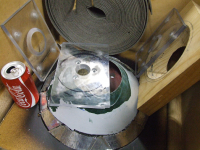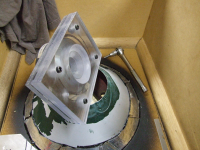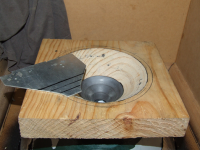What studies show that lower sensitivity drivers, for let's say frequencies below 200 Hz, leads to inferiour sound quality?
Do we know this for sure?
Isn't it possible to avoid power compression with multiple high quality smaller drivers and suited amplifier power?
Below 200 Hz I don't think that anyone is saying that lower sensitivity leads to inferior sound unless the design limits are exceeded. But this later issue is far more likely to occur with a low efficiency design than a high efficiency one.
It is possible to "avoid power compression with multiple high quality smaller drivers" and this is fine when interactions between drivers is not an issue like it is <200 Hz. At 2 kHz this is not at all the case and multiple drivers create more problems than they solve. Fewer is better above about 500-1000 Hz.
OK, I guess I've been off the game for a time. I'm implying that multiple sources can (even should) offer damping as a package. If this is correct I guess the only questions I have remaining from this is: Can the sources compensate for a lack of passive room damping and if not completely: could a room with solid walls permit low spatial variation that is damped through the sources and at the risk of digging further into the same hole, would these walls then increase reverberation time and hence level?Gedlee said:A poorly damped room would have a very high spatial variation - since your assumption is incorrect, the rest of the discussion is moot.
When multiple subs are setup properly, it can be shown the turning one off usually raises the response in the room in some band of frequencies. This means that this source is acting as active damping in this region. I am not sure this is a complete answer to your question, but it is part of it. It is still always best o have as much LF damping as you can.
I think the term "active damping" should be limited to motional feedback "traps".
Problem here in the land of engineering wannabees, is that displays are rarely better than two- or maybe three-factorial.
Like many little amateur HiFi enthusiasts, I have spent time reversing poles on woofers, by choice or through ignorance. I'd say it is the exceptional super-symmetrical set-up when it makes any over-all clear difference and ultimately a matter of taste in sound.
What I mean is that - even with the simplest of test tones - the sound varies inch by inch and freq by freq around the room. Granted, there's some very low freq when it does matter, maybe, but even so the range above may favor the other polarity. But that kind of thinking doesn't show up on simple graphs.
BTW, nobody could be as enthusiastic about the real-room value of multiple HETEROGENEOUS kinds of subs in heterogeneous locations as I am.
Ben
Problem here in the land of engineering wannabees, is that displays are rarely better than two- or maybe three-factorial.
Like many little amateur HiFi enthusiasts, I have spent time reversing poles on woofers, by choice or through ignorance. I'd say it is the exceptional super-symmetrical set-up when it makes any over-all clear difference and ultimately a matter of taste in sound.
What I mean is that - even with the simplest of test tones - the sound varies inch by inch and freq by freq around the room. Granted, there's some very low freq when it does matter, maybe, but even so the range above may favor the other polarity. But that kind of thinking doesn't show up on simple graphs.
BTW, nobody could be as enthusiastic about the real-room value of multiple HETEROGENEOUS kinds of subs in heterogeneous locations as I am.
Ben
Thank you. The picture shows only half of the length constructed.
For a given axial length (throat to mouth), increasing the radius decreases the length of the waveguide proper. Is both this length and the radius a tradeoff against the lowest frequencies to be produced? When I try to prove this I always find inconsistencies.
For a given axial length (throat to mouth), increasing the radius decreases the length of the waveguide proper. Is both this length and the radius a tradeoff against the lowest frequencies to be produced? When I try to prove this I always find inconsistencies.
Dr Geddes - I know you've done a lot of research into bass traps and room treatment. You were the first person to clue me into the idea of using Helmholtz bass traps.
I have a question -
Can one use unpowered sealed subs as bass traps?
For instance, one could construct a helmholtz bass trap, but calculating the volume of the box and the volume of the helmholtz resonator is a mystery to me. (Is it the same math as a vented box? I do not know.)
But it occurred to me that one could simply build a sealed box, pick a woofer with the proper FS, and leave the box unpowered. It seems to me that the woofer cone would act like a passive radiator, and would cancel out sound in the room at that frequency.
For instance, a Pyle PPA 15" costs $50.99 delivered, and has an FS that's a good match for the room mode I'm fighting.
Thoughts?
I have a question -
Can one use unpowered sealed subs as bass traps?
For instance, one could construct a helmholtz bass trap, but calculating the volume of the box and the volume of the helmholtz resonator is a mystery to me. (Is it the same math as a vented box? I do not know.)
But it occurred to me that one could simply build a sealed box, pick a woofer with the proper FS, and leave the box unpowered. It seems to me that the woofer cone would act like a passive radiator, and would cancel out sound in the room at that frequency.
An externally hosted image should be here but it was not working when we last tested it.
For instance, a Pyle PPA 15" costs $50.99 delivered, and has an FS that's a good match for the room mode I'm fighting.
Thoughts?
Take a look at this:Dr Geddes - I know you've done a lot of research into bass traps and room treatment. You were the first person to clue me into the idea of using Helmholtz bass traps.
I have a question -
Can one use unpowered sealed subs as bass traps?
For instance, one could construct a helmholtz bass trap, but calculating the volume of the box and the volume of the helmholtz resonator is a mystery to me. (Is it the same math as a vented box? I do not know.)
But it occurred to me that one could simply build a sealed box, pick a woofer with the proper FS, and leave the box unpowered. It seems to me that the woofer cone would act like a passive radiator, and would cancel out sound in the room at that frequency.
For instance, a Pyle PPA 15" costs $50.99 delivered, and has an FS that's a good match for the room mode I'm fighting.
Thoughts?
Untitled Document
Thoughts?
The Q is too low to be a good absorber IMO.
Now, if you design a TH with massive peaks in the same locations as the room modes...
I've actually measured dips in FR caused by my test TH being left unpowered and unconnected in my living room. Even published them somewhere, I think. Purposely designing one for this purpose may work.
I've actually measured dips in FR caused by my test TH being left unpowered and unconnected in my living room. Even published them somewhere, I think. Purposely designing one for this purpose may work.
Found it - http://www.diyaudio.com/forums/subwoofers/182464-th-bass-trap.html
MFB does the opposite - it prevents the cone from moving in response to external influence. (The backpressure of a small enclosure is an "external influence".)
Well then, there must be something in that family that does the trick?
How about an amp with a positive impedance equal to the driver? (In contrast to an MF amp whose output impedance is the negative of the driver.)
OK... sounds distinctly unstable.
Ben
If you arranged an amp/driver so that any external influence causing cone movement was amplified instead of canceled, it would act as a bass trap. You can prove the concept by using two subs, both driven but one out of phase with the other, and moving them about.
I think Brian and Patrick are on a more promising track, though. Broadband bass absorption / cancellation is, in my opinion, counterproductive. You don't want to reduce all bass equally - you may as well just turn down the bass in the first place. Trapping / canceling individual resonances is a more fruitful approach. The classical way is to use a 1/4 wave tube resonator placed at, and tuned to, the location and frequency of the mode to be canceled. A 1/4 wave tube is the basis of a tapped horn, so it might be possible to actively drive the tapped horn to amplify the resonance and increase the canceling effect.
... I see I spoke up in the "TH as trap" thread too...
I think Brian and Patrick are on a more promising track, though. Broadband bass absorption / cancellation is, in my opinion, counterproductive. You don't want to reduce all bass equally - you may as well just turn down the bass in the first place. Trapping / canceling individual resonances is a more fruitful approach. The classical way is to use a 1/4 wave tube resonator placed at, and tuned to, the location and frequency of the mode to be canceled. A 1/4 wave tube is the basis of a tapped horn, so it might be possible to actively drive the tapped horn to amplify the resonance and increase the canceling effect.
... I see I spoke up in the "TH as trap" thread too...
I don't see this being the case. If the walls were transparent to bass there'd be no room and no modes, and a fixed bass trap could in theory achieve the same thing to some degree....Where bass doesn't align itself to a specific mode, it will fall into the background but modal bass will continue for a time where both the peaks and dips could be accessed at some point, perhaps by a trap of some sort. The multi sub approach is just the same thing, but active. However, peaks and nulls can have modal energy added to/subtracted from them through various modes as well as being able to fight them in the source modes as an absorber would.Broadband bass absorption / cancellation is, in my opinion, counterproductive. You don't want to reduce all bass equally - you may as well just turn down the bass in the first place.
Dr Geddes - I know you've done a lot of research into bass traps and room treatment. You were the first person to clue me into the idea of using Helmholtz bass traps.
I have a question -
Can one use unpowered sealed subs as bass traps?
For instance, one could construct a helmholtz bass trap, but calculating the volume of the box and the volume of the helmholtz resonator is a mystery to me. (Is it the same math as a vented box? I do not know.)
But it occurred to me that one could simply build a sealed box, pick a woofer with the proper FS, and leave the box unpowered. It seems to me that the woofer cone would act like a passive radiator, and would cancel out sound in the room at that frequency.
Thoughts?
You could do that, but it would not be all that effective. Better is to use an amp and some electronics control to create an active absorber which would be much more effective, but better still is just to use the sub as a sub in a multi-sub setup. If done correctly, you will find that turning a sub on can actually reduce the sound level in some frequency range. Hence this sub IS acting as an absorber in that frequency range. You will find that all the subs do this over some frequency range. This means that a multi-sub setup IS an active absorber setup.
Unless the absorption is built into the room walls its not going to be very effective - multi-subs simply works and trumps all of the other approaches IMO.
You could do that, but it would not be all that effective. Better is to use an amp and some electronics control to create an active absorber which would be much more effective, but better still is just to use the sub as a sub in a multi-sub setup. If done correctly, you will find that turning a sub on can actually reduce the sound level in some frequency range. Hence this sub IS acting as an absorber in that frequency range. You will find that all the subs do this over some frequency range. This means that a multi-sub setup IS an active absorber setup.
Unless the absorption is built into the room walls its not going to be very effective - multi-subs simply works and trumps all of the other approaches IMO.
Now if we only had an active absorption technique that could tame modal decay with more precision, i.e. DBA/CABS without the strict placement requirements for low frequency sources.
- Home
- Loudspeakers
- Subwoofers
- Multiple Small Subs - Geddes Approach


